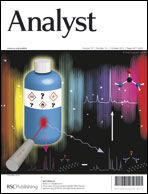DNA microarray fabricated on poly(acrylic acid) brushes-coated porous silicon by in situ rolling circle amplification
Abstract
Microarrays hold considerable promise in large-scale biology on account of their analytical, massive and parallel nature. In a step toward further enabling such a capability, we describe the application of rolling circle amplification (RCA) for a sensitive and multiplex detection of nucleic acid targets on


 Please wait while we load your content...
Please wait while we load your content...